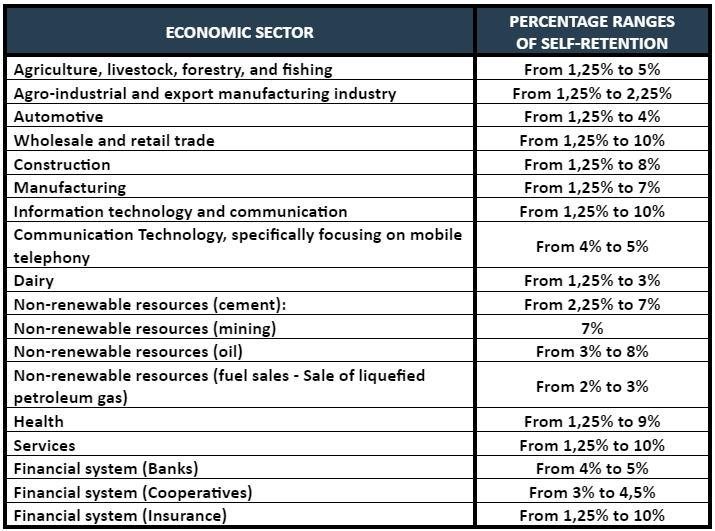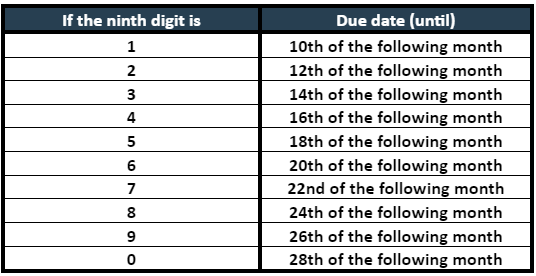Electronic Invoicing in Ecuador
The Internal Revenue Service (IRS) announced on February 29, 2024, significant tax modifications with the issuance of RESOLUTION No. NAC-DGERCGC24-00000008, which establishes new withholding rates starting from March 2024.
Electronic invoicing in Ecuador is in the final stages of its implementation. Initiated in 2014 by the Internal Revenue Service of Ecuador - SRI, the project was completed in November 2022 with the inclusion of 100% of all taxpayers.
Table of Contents [Hide]
- Electronic Invoicing System in Ecuador
- Requirements for Becoming an Electronic Invoice Issuer
- Electronic Invoices
- Types of Electronic Invoices
- Format of Electronic Invoices
- Archiving Electronic Invoices
- Tax reform: "Organic Law of Economic Efficiency and Job Creation"
- How to Automate the Issuance and Receipt of Electronic Invoices
Electronic Invoicing System in Ecuador
The electronic invoicing system in Ecuador follows an emission model called “Offline”. “Comprobantes electrónicos” are the name given to electronic invoices. Electronic invoices are generated and signed through the electronic invoicing platform contracted by the issuer. These electronic invoices are sent to the SRI, which validates and authorizes them. Once validated and authorized, they are sent to the recipient, including the authorization code assigned by the SRI, along with a graphical representation called RIDE. It is important to note that recipients must have given their consent to receive electronic invoices. In case there is no recipient consent, or if the recipient expressly requests the printed invoice, the issuers must print and deliver the RIDE.
Requirements for Becoming an Electronic Invoice Issuer
- Have an electronic signature certificate.
- Have a solution for generating electronic invoices in accordance with the technical requirements of the SRI.
- Be registered with SRI en Línea (Form 361).
- Have a registered debit agreement (Convenio de débito).
Electronic Invoices
Electronic invoices are electronic format tax documents that comply with the legal and regulatory requirements of the SRI.
Types of Electronic Invoices
- Invoices
- Purchase orders for goods and services
- Credit notes
- Debit notes
- Withholding certificates
- Dispatch Avises
Format
Structured file XML format with Digital Signature. XML 1.0.
Storage
Mandatory for both the issuer and recipient to store electronic invoices for 7 years.
New Resolution No. NAC-DGERCGC24-00000008
The Internal Revenue Service (IRS) announced on February 29, 2024, significant tax modifications with the issuance of RESOLUTION No. NAC-DGERCGC24-00000008, which establishes new withholding rates starting from March 2024.
The update, detailed in version EC v2.26, includes significant changes that impact both the Value Added Tax (VAT) and the income tax withholding percentages.
Key elements of the regulation include:
- New 13% VAT rate: An adjustment to the VAT rate has been made, setting it at 13%.
- Updated income tax withholding percentages: New income tax withholding rates at the source have been set, which must be applied by taxpayers when making payments or crediting taxable income.
The withholding percentages vary between 0% and 10%, with different scales detailed in the resolution. Additionally, it is specified that payments not covered by specific withholding percentages will be subject to a 2.75% withholding.
Key aspects of the regulation cover withholding for payments made to non-residents for occasional services, the application of multiple percentages depending on the type of income, and some specific exceptions.
It is important to note that withholding will be carried out at the time of payment or credit to the account, whichever occurs first. On the other hand, payment aggregators and online marketplaces are allowed to issue a single withholding certificate that covers all transactions carried out during a month.
These measures represent a significant adjustment in tax obligations and aim to strengthen the fiscal system to ensure fairness and efficiency in tax collection.
Tax reform: "Organic Law of Economic Efficiency and Job Creation"
On December 19, 2023, the National Assembly approved the tax reform known as the 'Organic Law for Economic Efficiency and Employment Generation', which came into effect on January 1, 2024.
The most important characteristics of the tax reform are:
1. Self-Retention Issuance:
- In the reform, it is specified that individuals classified as large taxpayers won't be subject to withholding tax on Income Tax at the source, except under certain circumstances. Instead, they are required to perform monthly self-retention on all their taxable income.
- On January 12, RESOLUTION No. NAC-DGERCGC24-00000003 was formally issued to establish the regulations governing the self-retention of income tax payable by corporations classified as large taxpayers.
Self-retentions will be applied to monthly taxable income, and a corresponding withholding certificate will be issued.
Exceptions to self-retention:
Exceptions to self-retention include income sources such as contracts for the exploration and exploitation of hydrocarbons in Ecuador, contracts with governmental entities, decentralized autonomous governments, and social security entities.
Taxable income subject to special Income Tax regimes under the Internal Tax Regime Law and income subject to other self-retention regimes established by law are also exempt.
Calculation exceptions:
In cases where a large taxpayer cannot differentiate between taxable and exempt income, the self-retention will be calculated based on the total monthly income received.
The percentage ranges for self-correction according to the economic sector are as follows:

- Surcharge: Failure to fulfill the self-retention obligations, either in full or partially, obligates the taxpayer to pay the due amounts along with corresponding interests. Additionally, they are subject to a fine equivalent to 100% of the retention.
- Settlement and payment: The declaration and payment procedure for self-retentions, as per this regulation, mirrors that of withholding tax at the source of income tax.
- Presentation and payment of the declaration: The declaration and payment must be made by the eleventh (11th) day of the relevant month, irrespective of the ninth digit of the taxpayer's Unique Taxpayer Registry.
- Deadlines for declaring and paying: Declarations and payments must be made by the following dates, considering the ninth digit of the RUC number:
2. The inclusion of the text "LARGE TAXPAYERS" along with the resolution number that qualifies them as such is required in electronic receipts.
On December 29, 2023, Decree 99 was issued, stipulating that taxpayers classified as Large Taxpayers by the Tax Administration must incorporate the phrase "Large Taxpayer" along with the corresponding resolution number into their electronic sales receipts. They are required to utilize suitable methods for this purpose.
What are the amendments incorporated into Decree No. 430 of 2010?
The amendments to Decree No. 430-2010, referred to as the "Regulation of Sales Receipts, Retention, and Supplementary Documents," mandate the inclusion of a designation on the electronic sales receipt that specifies the taxpayer's classification, marking them as a "Large Taxpayer," and provides the related resolution number.
"15. Taxpayers designated as Large Taxpayers by the Tax Administration are required to incorporate, using the appropriate methods, the phrase: 'Large Taxpayer' along with the resolution number granting them this status, into their electronic sales receipts."
This means that the printed version of the electronic document (RIDE) should enable the display of this information.
How can I find out if I am categorized as a large taxpayer?
Companies identified as "Large Taxpayers" are listed in the "Large Taxpayers Registry." Should you have questions or wish to verify if your company is classified as a "Large Taxpayer," please reach out to our commercial team.
Automatic Solution for Issuing Electronic Invoices
EDICOM has developed an international electronic invoicing platform that allows generating, sending, and storing electronic invoices in accordance with the requirements established by the Internal Revenue Service of Ecuador.
This process is carried out automatically, reducing the time spent on these administrative tasks for businesses. The implementation of electronic invoicing is fast and straightforward. All Ecuadorian taxpayers who wish to can adopt this new electronic system using the services of EDICOM.



